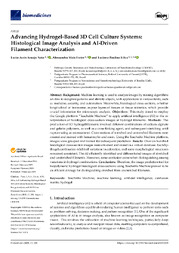Advancing Hydrogel-Based 3D Cell Culture Systems: Histological Image Analysis and AI-Driven Filament Characterization.
Advancing Hydrogel-Based 3D Cell Culture Systems: Histological Image Analysis and AI-Driven Filament Characterization.
Autoria: ARAUJO NETO, L. A.; FREIRE, A. M.; SILVA, L. P. da
Resumo: Background: Machine learning is used to analyze images by training algorithms on data to recognize patterns and identify objects, with applications in various fields, such as medicine, security, and automation. Meanwhile, histological cross-sections, whether longitudinal or transverse, expose layers of tissues or tissue mimetics, which provide crucial information for microscopic analysis. Objectives: This study aimed to employ the Google platform “Teachable Machine” to apply artificial intelligence (AI) in the interpretation of histological cross-section images of hydrogel filaments. Methods: The production of 3D hydrogel filaments involved different combinations of sodium alginate and gelatin polymers, as well as a cross-linking agent, and subsequent stretching until rupture using an extensometer. Cross-sections of stretched and unstretched filaments were created and stained with hematoxylin and eosin. Using the Teachable Machine platform, images were grouped and trained for subsequent prediction. Results: Over six hundred histological cross-section images were obtained and stored in a virtual database. Each hydrogel combination exhibited variations in coloration, and some morphological structures remained consistent. The AI efficiently identified and differentiated images of stretched and unstretched filaments. However, some confusion arose when distinguishing among variations in hydrogel combinations. Conclusions: Therefore, the image prediction tool for biopolymeric hydrogel histological cross-sections using Teachable Machine proved to be an efficient strategy for distinguishing stretched from unstretched filaments.
Ano de publicação: 2025
Tipo de publicação: Artigo de periódico
Palavras-chave: Artificial intelligence, Confusion matrix, Hydrogel, Machine learning, Teachable Machine
Observações
1 - Por padrão são exibidas publicações dos últimos 20 anos. Para encontrar publicações mais antigas, configure o filtro ano de publicação, colocando o ano a partir do qual você deseja encontrar publicações. O filtro está na coluna da esquerda na busca acima.
2 - Para ler algumas publicações da Embrapa (apenas as que estão em formato ePub), é necessário ter, no celular ou computador, um desses softwares gratuitos. Sistemas Android: Google Play Livros; IOS: iBooks; Windows e Linux: software Calibre.
Acesse outras publicações
Acesse a Base de Dados da Pesquisa Agropecuária (BDPA) para consultar o acervo completo das bibliotecas da Embrapa.

